Tutorial: Configure an Application Gateway with TLS termination using the Azure portal
You can use the Azure portal to configure an application gateway with a certificate for TLS termination that uses virtual machines for backend servers.
In this tutorial, you learn how to:
- Create a self-signed certificate
- Create an application gateway with the certificate
- Create the virtual machines used as backend servers
- Test the application gateway
If you don't have an Azure subscription, create a free account before you begin.
Note
We recommend that you use the Azure Az PowerShell module to interact with Azure. To get started, see Install Azure PowerShell. To learn how to migrate to the Az PowerShell module, see Migrate Azure PowerShell from AzureRM to Az.
Prerequisites
- An Azure subscription
Create a self-signed certificate
In this section, you use New-SelfSignedCertificate to create a self-signed certificate. You upload the certificate to the Azure portal when you create the listener for the application gateway.
On your local computer, open a Windows PowerShell window as an administrator. Run the following command to create the certificate:
New-SelfSignedCertificate `
-certstorelocation cert:\localmachine\my `
-dnsname www.contoso.com
You should see something like this response:
PSParentPath: Microsoft.PowerShell.Security\Certificate::LocalMachine\my
Thumbprint Subject
---------- -------
E1E81C23B3AD33F9B4D1717B20AB65DBB91AC630 CN=www.contoso.com
Use Export-PfxCertificate with the Thumbprint that was returned to export a pfx file from the certificate. The supported PFX algorithms are listed at PFXImportCertStore function. Make sure your password is 4 - 12 characters long:
$pwd = ConvertTo-SecureString -String <your password> -Force -AsPlainText
Export-PfxCertificate `
-cert cert:\localMachine\my\E1E81C23B3AD33F9B4D1717B20AB65DBB91AC630 `
-FilePath c:\appgwcert.pfx `
-Password $pwd
Sign in to Azure
Sign in to the Azure portal.
Create an application gateway
From the Azure portal menu, select + Create a resource > Networking > Application Gateway, or search for Application Gateway in the portal search box.
Select Create.
Basics tab
On the Basics tab, enter or select these values:
Resource group: Select myResourceGroupAG for the resource group. If it doesn't exist, select Create new to create it.
Application gateway name: Enter myAppGateway for the name of the application gateway.
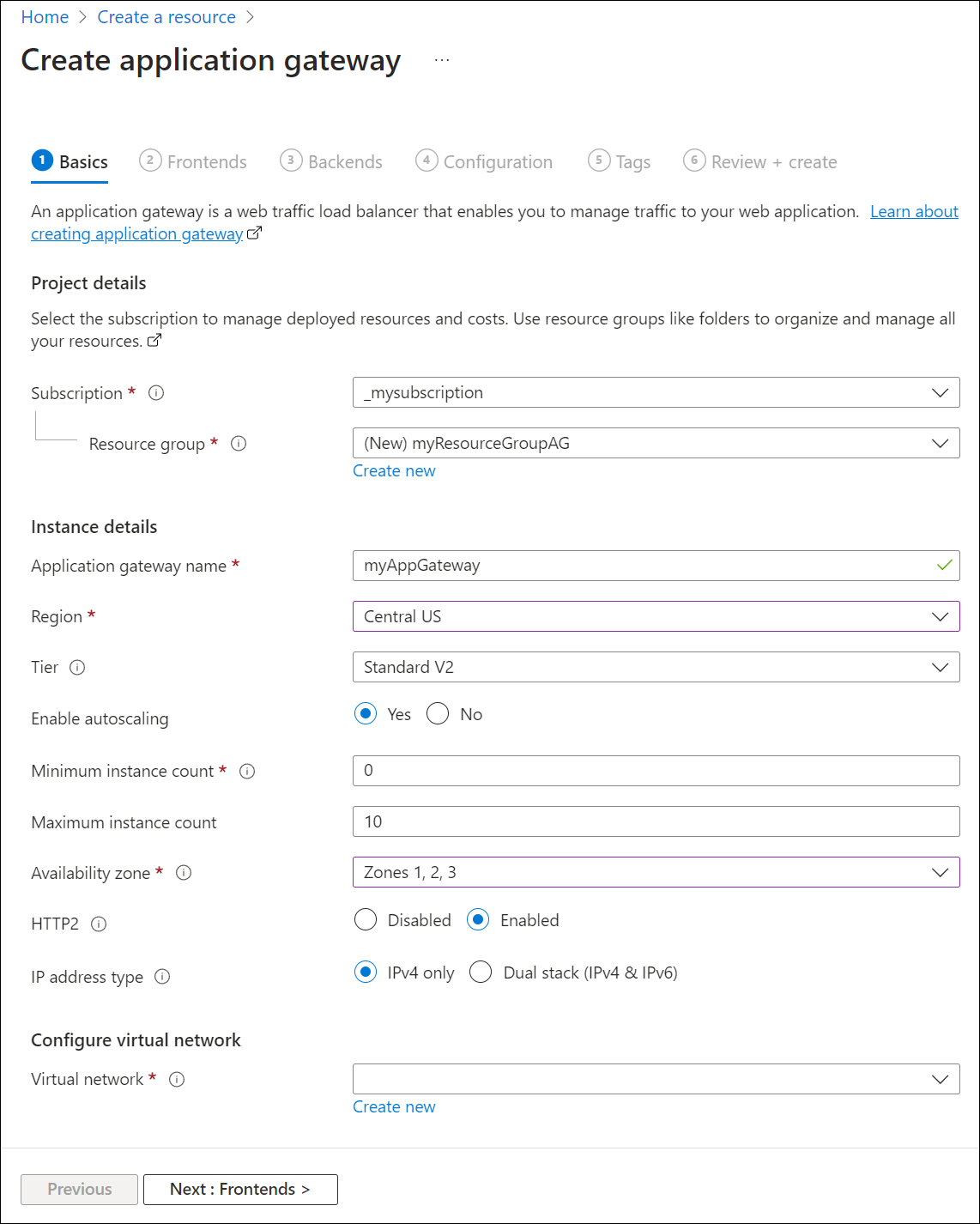
For Azure to communicate between the resources that you create, it needs a virtual network. You can either create a new virtual network or use an existing one. In this example, you'll create a new virtual network at the same time that you create the application gateway. Application Gateway instances are created in separate subnets. You create two subnets in this example: one for the application gateway, and another for the backend servers.
Under Configure virtual network, create a new virtual network by selecting Create new. In the Create virtual network window that opens, enter the following values to create the virtual network and two subnets:
Name: Enter myVNet for the name of the virtual network.
Subnet name (Application Gateway subnet): The Subnets grid will show a subnet named Default. Change the name of this subnet to myAGSubnet.
The application gateway subnet can contain only application gateways. No other resources are allowed.Subnet name (backend server subnet): In the second row of the Subnets grid, enter myBackendSubnet in the Subnet name column.
Address range (backend server subnet): In the second row of the Subnets Grid, enter an address range that doesn't overlap with the address range of myAGSubnet. For example, if the address range of myAGSubnet is 10.0.0.0/24, enter 10.0.1.0/24 for the address range of myBackendSubnet.
Select OK to close the Create virtual network window and save the virtual network settings.
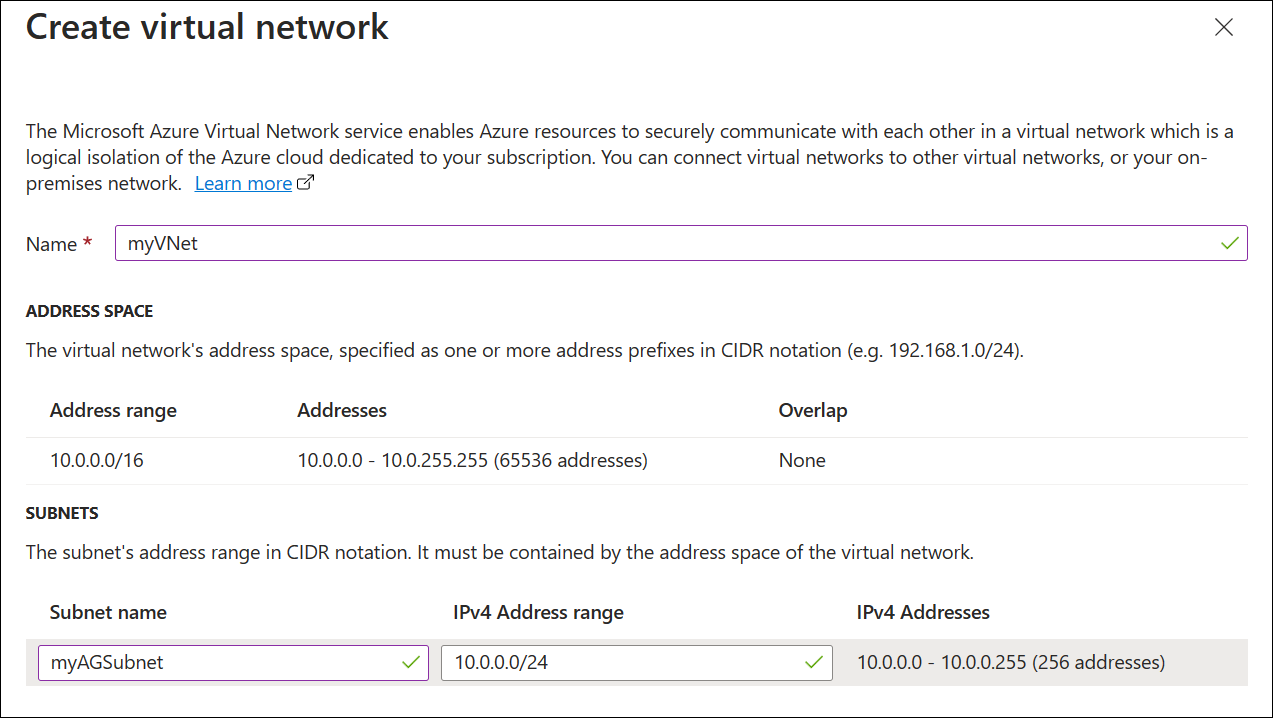
On the Basics tab, accept the default values for the other settings and then select Next: Frontends.
Frontends tab
On the Frontends tab, verify Frontend IP address type is set to Public.
You can configure the Frontend IP to be Public or Private as per your use case. In this example, you'll choose a Public Frontend IP.Note
For the Application Gateway v2 SKU, you can only choose Public frontend IP configuration. Private frontend IP configuration is currently not enabled for this v2 SKU.
Choose Add new for the Public IP address and enter myAGPublicIPAddress for the public IP address name, and then select OK.
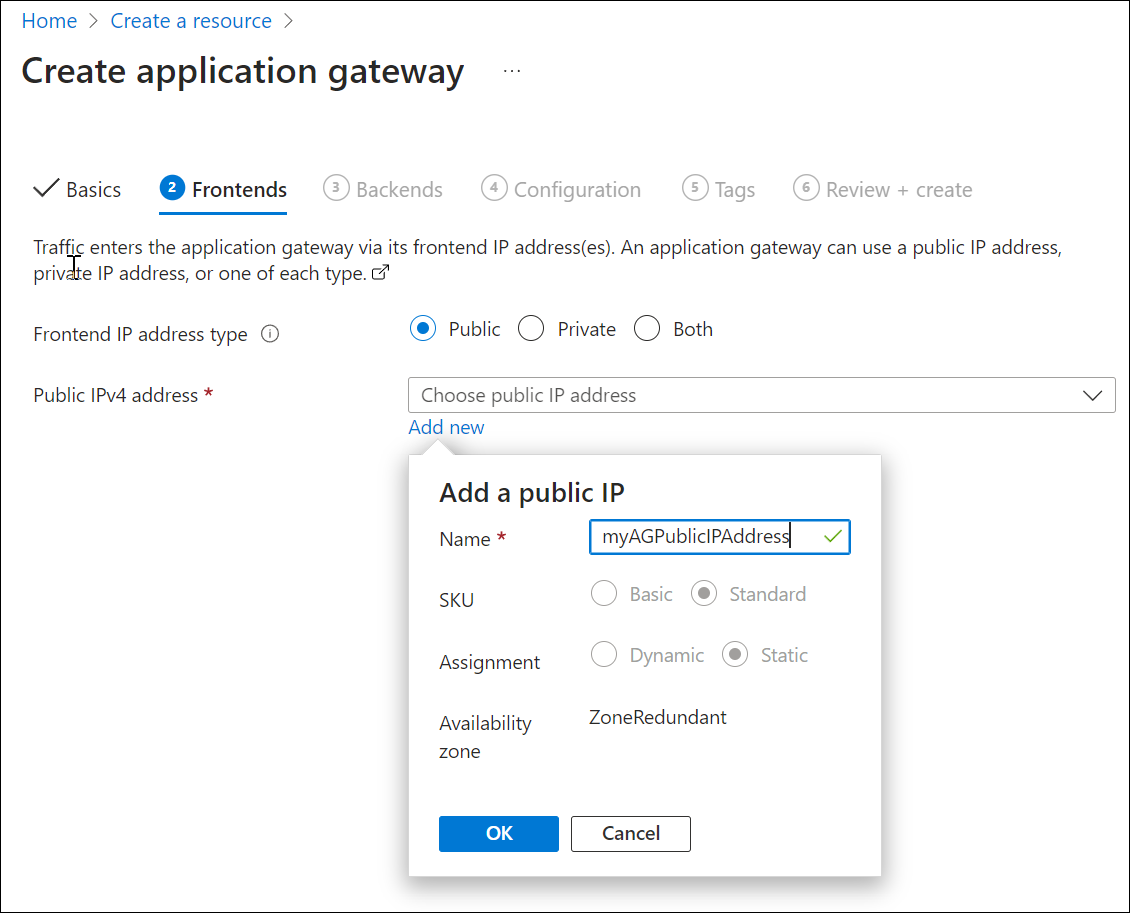
Select Next: Backends.
Backends tab
The backend pool is used to route requests to the backend servers that serve the request. Backend pools can be composed of NICs, virtual machine scale sets, public IPs, internal IPs, fully qualified domain names (FQDN), and multitenant backends like Azure App Service. In this example, you'll create an empty backend pool with your application gateway and then add backend targets to the backend pool.
On the Backends tab, select Add a backend pool.
In the Add a backend pool window that opens, enter the following values to create an empty backend pool:
- Name: Enter myBackendPool for the name of the backend pool.
- Add backend pool without targets: Select Yes to create a backend pool with no targets. You'll add backend targets after creating the application gateway.
In the Add a backend pool window, select Add to save the backend pool configuration and return to the Backends tab.

On the Backends tab, select Next: Configuration.
Configuration tab
On the Configuration tab, you'll connect the frontend and backend pool you created using a routing rule.
Select Add a routing rule in the Routing rules column.
In the Add a routing rule window that opens, enter myRoutingRule for the Rule name.
A routing rule requires a listener. On the Listener tab within the Add a routing rule window, enter the following values for the listener:
- Listener name: Enter myListener for the name of the listener.
- Frontend IP: Select Public to choose the public IP you created for the frontend.
- Protocol: Select HTTPS.
- Port: Verify 443 is entered for the port.
Under HTTPS Settings:
Choose a certificate - Select Upload a certificate.
PFX certificate file - Browse to and select the c:\appgwcert.pfx file that you create earlier.
Certificate name - Type mycert1 for the name of the certificate.
Password - Type the password you used to create the certificate.
Accept the default values for the other settings on the Listener tab, then select the Backend targets tab to configure the rest of the routing rule.

On the Backend targets tab, select myBackendPool for the Backend target.
For the HTTP setting, select Add new to create a new HTTP setting. The HTTP setting will determine the behavior of the routing rule. In the Add a HTTP setting window that opens, enter myHTTPSetting for the HTTP setting name. Accept the default values for the other settings in the Add a HTTP setting window, then select Add to return to the Add a routing rule window.

On the Add a routing rule window, select Add to save the routing rule and return to the Configuration tab.
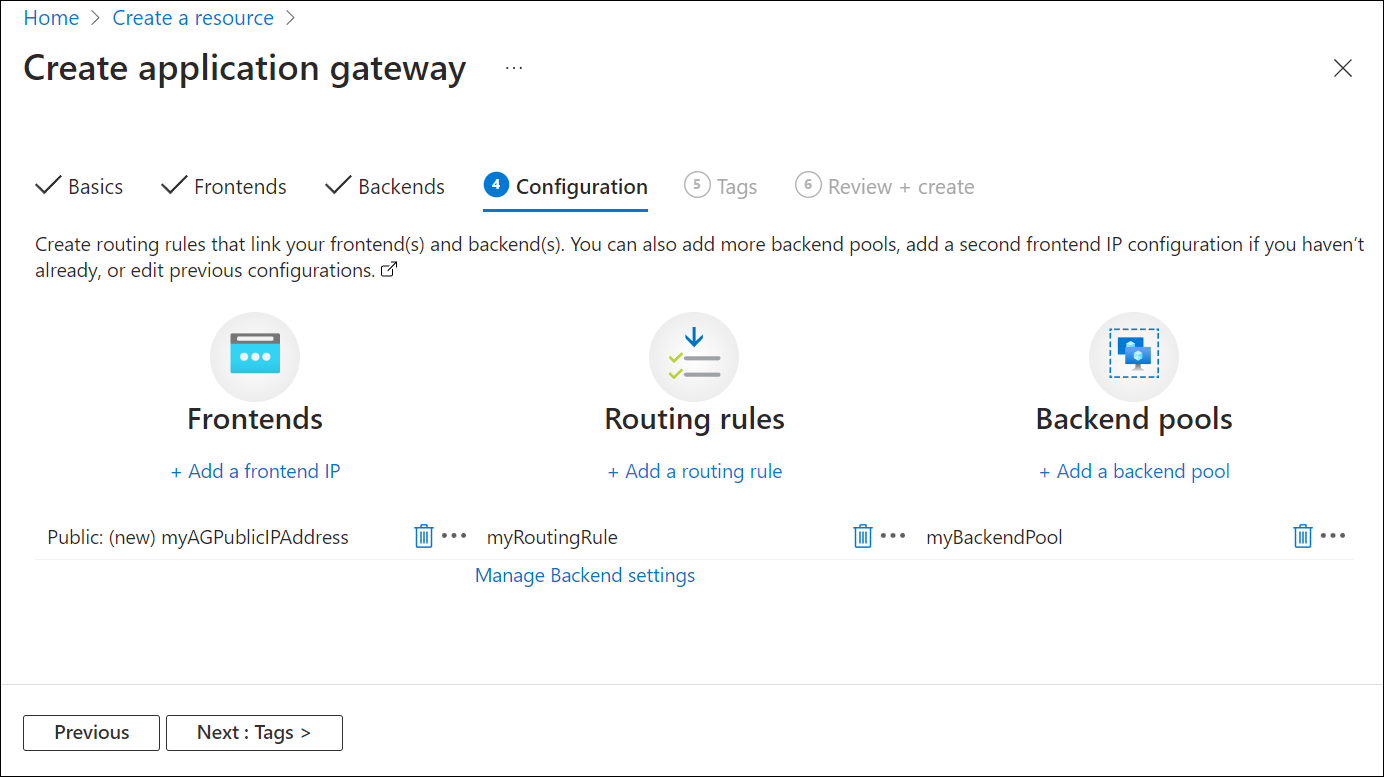
Select Next: Tags and then Next: Review + create.
Review + create tab
Review the settings on the Review + create tab, and then select Create to create the virtual network, the public IP address, and the application gateway. It may take several minutes for Azure to create the application gateway. Wait until the deployment finishes successfully before moving on to the next section.
Add backend targets
In this example, you'll use virtual machines as the target backend. You can either use existing virtual machines or create new ones. You'll create two virtual machines that Azure uses as backend servers for the application gateway.
To do this, you'll:
- Create two new VMs, myVM and myVM2, to be used as backend servers.
- Install IIS on the virtual machines to verify that the application gateway was created successfully.
- Add the backend servers to the backend pool.
Create a virtual machine
From the Azure portal menu, select + Create a resource > Compute > Windows Server 2016 Datacenter, or search for Windows Server in the portal search box and select Windows Server 2016 Datacenter.
Select Create.
Application Gateway can route traffic to any type of virtual machine used in its backend pool. In this example, you use a Windows Server 2016 Datacenter.
Enter these values in the Basics tab for the following virtual machine settings:
- Resource group: Select myResourceGroupAG for the resource group name.
- Virtual machine name: Enter myVM for the name of the virtual machine.
- Username: Enter a name for the administrator user name.
- Password: Enter a password for the administrator account.
Accept the other defaults and then select Next: Disks.
Accept the Disks tab defaults and then select Next: Networking.
On the Networking tab, verify that myVNet is selected for the Virtual network and the Subnet is set to myBackendSubnet. Accept the other defaults and then select Next: Management.
Application Gateway can communicate with instances outside of the virtual network that it is in, but you need to ensure there's IP connectivity.
On the Management tab, set Boot diagnostics to Disable. Accept the other defaults and then select Review + create.
On the Review + create tab, review the settings, correct any validation errors, and then select Create.
Wait for the deployment to complete before continuing.
Install IIS for testing
In this example, you install IIS on the virtual machines only to verify Azure created the application gateway successfully.
Open Azure PowerShell. To do so, select Cloud Shell from the top navigation bar of the Azure portal and then select PowerShell from the drop-down list.
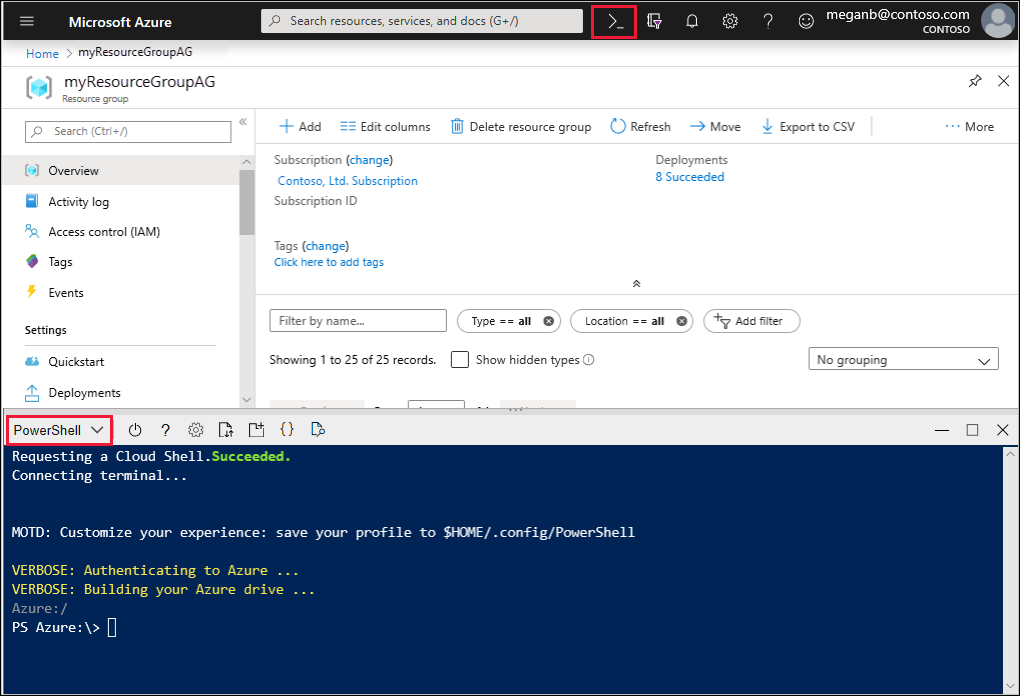
Change the location setting for your environment, and then run the following command to install IIS on the virtual machine:
Set-AzVMExtension ` -ResourceGroupName myResourceGroupAG ` -ExtensionName IIS ` -VMName myVM ` -Publisher Microsoft.Compute ` -ExtensionType CustomScriptExtension ` -TypeHandlerVersion 1.4 ` -SettingString '{"commandToExecute":"powershell Add-WindowsFeature Web-Server; powershell Add-Content -Path \"C:\\inetpub\\wwwroot\\Default.htm\" -Value $($env:computername)"}' ` -Location <location>Create a second virtual machine and install IIS by using the steps that you previously completed. Use myVM2 for the virtual machine name and for the VMName setting of the Set-AzVMExtension cmdlet.
Add backend servers to backend pool
Select All resources, and then select myAppGateway.
Select Backend pools from the left menu.
Select myBackendPool.
Under Target type, select Virtual machine from the drop-down list.
Under Target, select the network interface under myVM from the drop-down list.
Repeat to add the network interface for myVM2.
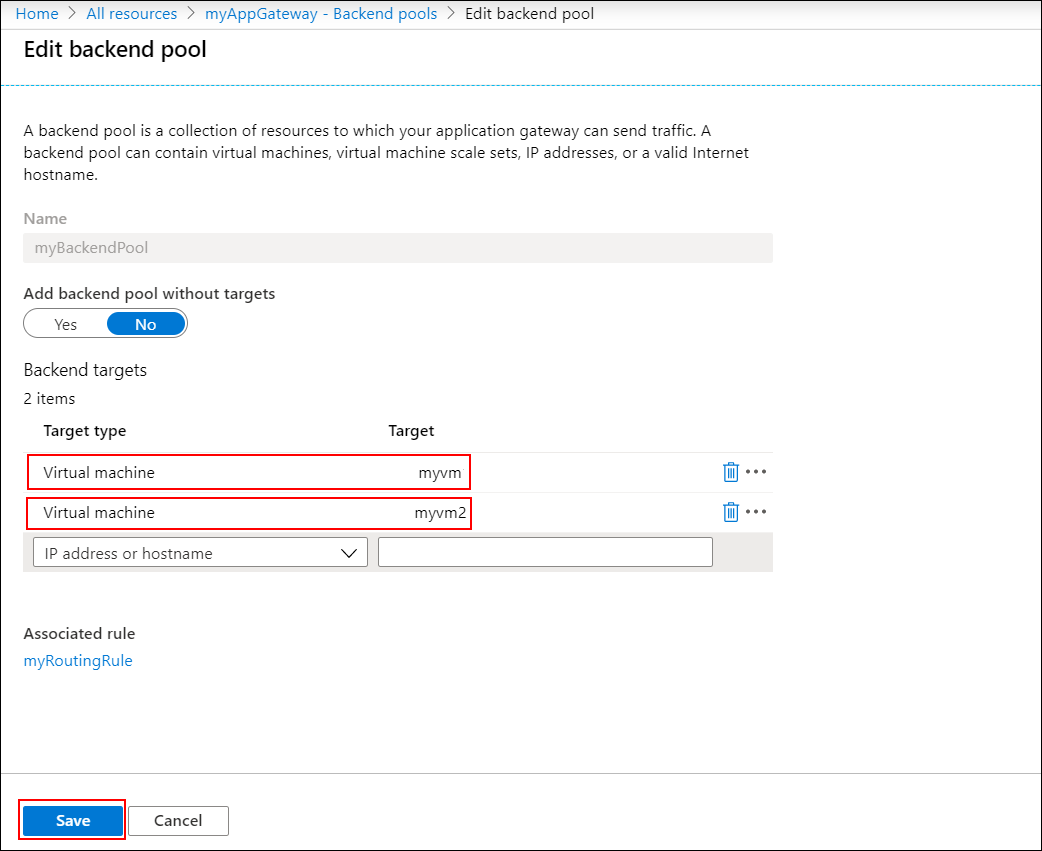
Select Save.
Wait for the deployment to complete before proceeding to the next step.
Test the application gateway
Select All resources, and then select myAGPublicIPAddress.

In the address bar of your browser, type https://<your application gateway ip address>.
To accept the security warning if you used a self-signed certificate, select Details (or Advanced on Chrome) and then go on to the webpage:

Your secured IIS website is then displayed as in the following example:

Clean up resources
When no longer needed, delete the resource group and all related resources. To do so, select the resource group and select Delete resource group.
Next steps
In this tutorial, you:
- Created a self-signed certificate
- Created an application gateway with the certificate
To learn more about Application Gateway TLS support, see end to end TLS with Application Gateway and Application Gateway TLS policy.
To learn how to create and configure an Application Gateway to host multiple web sites using the Azure portal, advance to the next tutorial.